2017年04月30日
★中国 鳥鎮の生活★
中国は、鳥鎮(ウ-ジェン)というところに来た。
ここに、安曇族の謎が隠されているのだ★

ウ-ジェンは、中国の江南地方というところに位置する。
以前、北九州の志賀島で手に入れた、古文書によると、「安曇族は中国の江南地方から海を越えて日本に渡っていった…たぶん。」と書かれていた。
これは有力な情報に違いない。
なぜなら、映画や物語は、ありえないようなわずかな情報から、真実にたどりつくからだ。
そのときのようす↓

志賀海神社にて、巫女から譲り受けた秘密の文献を早速開いてみた。
…ついにここに、安曇族に関する隠された謎を解く鍵が書かれているのだな…('ー')
文献を開くと、まずはじめに、こう書かれていた…。
『佳奈ちゃんの"ふくおか・あづみの交流物語』

…。
…(^^;)
…うむ。これは…読みやすい。学の無い海賊の俺でも理解できそうだ!!
俺は文献を読みすすめていく…。
『もうすぐ福岡空港に到着します。との機内放送に、佳奈ちゃんは目が覚めました。真下に広がる海には博多湾を玄界灘からさえぎる「海の中道』が腕のように伸びていてその先端に佳奈ちゃんが住んでいる志賀島が橋でつながっています。それから、飛行機はどんどん高度を下げて福岡のビルの上を滑るようにして空港に到着しました。佳奈ちゃんは、志賀島小学校6年生。夏休みに東区役所が…。』
…。
俺はさらに読みすすめた。
これを読んでいくと、おじいちゃんと呼ばれる老人が、佳奈ちゃんに伝説を語りついでいるようだ…。

おじいちゃんの話りによると…
●大昔に志賀島の人々が安曇野に移り住んだ
●その言い伝えは志賀海神社の阿曇宮司から聞いた。
●あづみ族は、志賀島を拠点として、船の技術や海の事情に詳しい海洋民族であった。
ことがわかる。
そして、さらに新しい情報が!!
そのあづみ族は、今から2500年くらい前に、中国の江南地方から渡ってきて住み着いた!!
という説がある。
大きな地図で見る
そして、江南地方は米の原産地とも言われており、日本に米の栽培技術をもたらしたのもあづみ族だという研究者もいる!!
さらに読みすすめていくと…。
それらの諸説の根拠となるものが、この志賀島で発見されていたのだ!!
それは
『金印』
というものらしい。
この金印は、その昔、中国の皇帝が当時の日本の王に授けたものらしい。
それは、数々の歴史書にも書かれているらしい。
また、あづみ族が活躍した弥生時代から、九州、中国大陸、朝鮮半島の間では、よく人々の行き来があった。
その当時、日本では銅や鉄がとれなかったので、朝鮮半島から金属の材料をもらっていろいろな道具をつくった。
また、日本最初の国史といわれる『日本書紀』や『万葉集』にあづみ族の話がいくつかでている。
…万葉集!?
そうか!! 万葉集というのは、日本の歴史を解くのに重要な文献だったってことか!!
日本書紀には、白村江(はくすきえ)の戦いで活躍した『あづみ族の比羅夫(ひらふ)』のことが書かれている。
この比羅夫の石像が、今の穂高神社に鎮座しているのだ!!

そして、比羅夫の命日に、穂高神社で『御船祭り』が行われている。
穂高神社の穂高見神(ほたかみのかみ)は、志賀海神社の神である『綿津見神』の御子神になっているのだ!!
志賀海神社では『山ほめ祭』が春と秋にある。これは山に感謝する祭りだ!!
志賀島と安曇野は遥か昔につながっていて、日本と中国、朝鮮半島との間で交流が行われ、あづみ族によって日本の鉄や稲をつくる文化が始まったのだ!!
そしてあづみ族は、日本の各地にその足跡を残し、最後に長野県の安曇野に永住したのだ!!
…。
…まさか、こんな展開になるなんて。
…正直、まったく予想していなかった(^。^;)
俺はただ、新宿の預言者の言葉を信じ、安曇野にきただけだったのだが…。
これは、俺に託したい、何かのメッセージなのかい?
海神(わたつみ)の神様よ…。
ここに、安曇族の謎が隠されているのだ★

ウ-ジェンは、中国の江南地方というところに位置する。
以前、北九州の志賀島で手に入れた、古文書によると、「安曇族は中国の江南地方から海を越えて日本に渡っていった…たぶん。」と書かれていた。
これは有力な情報に違いない。
なぜなら、映画や物語は、ありえないようなわずかな情報から、真実にたどりつくからだ。
そのときのようす↓
志賀海神社にて、巫女から譲り受けた秘密の文献を早速開いてみた。
…ついにここに、安曇族に関する隠された謎を解く鍵が書かれているのだな…('ー')
文献を開くと、まずはじめに、こう書かれていた…。
『佳奈ちゃんの"ふくおか・あづみの交流物語』
…。
…(^^;)
…うむ。これは…読みやすい。学の無い海賊の俺でも理解できそうだ!!
俺は文献を読みすすめていく…。
『もうすぐ福岡空港に到着します。との機内放送に、佳奈ちゃんは目が覚めました。真下に広がる海には博多湾を玄界灘からさえぎる「海の中道』が腕のように伸びていてその先端に佳奈ちゃんが住んでいる志賀島が橋でつながっています。それから、飛行機はどんどん高度を下げて福岡のビルの上を滑るようにして空港に到着しました。佳奈ちゃんは、志賀島小学校6年生。夏休みに東区役所が…。』
…。
俺はさらに読みすすめた。
これを読んでいくと、おじいちゃんと呼ばれる老人が、佳奈ちゃんに伝説を語りついでいるようだ…。
おじいちゃんの話りによると…
●大昔に志賀島の人々が安曇野に移り住んだ
●その言い伝えは志賀海神社の阿曇宮司から聞いた。
●あづみ族は、志賀島を拠点として、船の技術や海の事情に詳しい海洋民族であった。
ことがわかる。
そして、さらに新しい情報が!!
そのあづみ族は、今から2500年くらい前に、中国の江南地方から渡ってきて住み着いた!!
という説がある。
大きな地図で見る
そして、江南地方は米の原産地とも言われており、日本に米の栽培技術をもたらしたのもあづみ族だという研究者もいる!!
さらに読みすすめていくと…。
それらの諸説の根拠となるものが、この志賀島で発見されていたのだ!!
それは
『金印』
というものらしい。
この金印は、その昔、中国の皇帝が当時の日本の王に授けたものらしい。
それは、数々の歴史書にも書かれているらしい。
また、あづみ族が活躍した弥生時代から、九州、中国大陸、朝鮮半島の間では、よく人々の行き来があった。
その当時、日本では銅や鉄がとれなかったので、朝鮮半島から金属の材料をもらっていろいろな道具をつくった。
また、日本最初の国史といわれる『日本書紀』や『万葉集』にあづみ族の話がいくつかでている。
…万葉集!?
そうか!! 万葉集というのは、日本の歴史を解くのに重要な文献だったってことか!!
日本書紀には、白村江(はくすきえ)の戦いで活躍した『あづみ族の比羅夫(ひらふ)』のことが書かれている。
この比羅夫の石像が、今の穂高神社に鎮座しているのだ!!

そして、比羅夫の命日に、穂高神社で『御船祭り』が行われている。
穂高神社の穂高見神(ほたかみのかみ)は、志賀海神社の神である『綿津見神』の御子神になっているのだ!!
志賀海神社では『山ほめ祭』が春と秋にある。これは山に感謝する祭りだ!!
志賀島と安曇野は遥か昔につながっていて、日本と中国、朝鮮半島との間で交流が行われ、あづみ族によって日本の鉄や稲をつくる文化が始まったのだ!!
そしてあづみ族は、日本の各地にその足跡を残し、最後に長野県の安曇野に永住したのだ!!
…。
…まさか、こんな展開になるなんて。
…正直、まったく予想していなかった(^。^;)
俺はただ、新宿の預言者の言葉を信じ、安曇野にきただけだったのだが…。
これは、俺に託したい、何かのメッセージなのかい?
海神(わたつみ)の神様よ…。
2014年06月02日
Itsukushima shrine⑧O-Torii 大鳥居
Day 4 April 2014
2014年4月4日
Sequel to the last article…
前回の続き
俺は大鳥居に向かった。
I went to the 'O-Torii'.
俺が大鳥居に向かおうとすると、太陽の光が雲の切れ目からさしはじめた。
The sun appears in the cloud when I go to 'O-Torii'.



大鳥居に向かっていた俺だが俺は何かを感じてなぜか鳥居から離れて行った。
However, I went away from ' O-Torii '.
I don't understand the reason.
However, I feel like someone is calling me.
誰かが俺を呼んでいる…
Someone's calling me…

感じる…
I feel…
人ではない、不思議な力を感じる
…mysterious power of something.

誰かが呼んでいる…。
Someone's calling me….
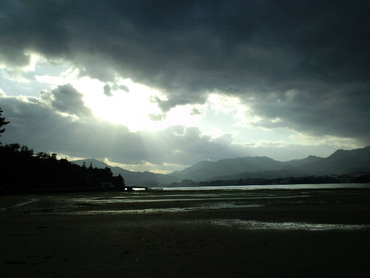
知らぬ間に俺は、誰も居ない海岸に来ていた…。
I arrived at the beach.
Nobody is there on the beach….
雲の上から声が聞こえる…。
I hear voice coming from above the clouds.
女の美しい声だ。
It is a beautiful voice of women.
声の主は俺に言った。
The voice is telling me something.
謎の声:「海賊よ。お前は知っているはずだ。私達がどこにいるのかを。」
The mysterious voice said, " Pirate, you should know where we are.
俺:「たしかに。俺はあなたたちがどこにいるのかを知っている( ̄ー+ ̄)
ところで、あなたは大事なことを忘れている。」
I answered, " Yes, that is true. I knew that where you are. By the way, you forget something important. ( ̄ー+ ̄)
謎の声:「何!?」
The voice said, " What ?! ∑(;゚□゚)yヾ "
俺:「あなたは俺が船長だってことを忘れている。お嬢様。( ̄▽ ̄)」
I answered, " You forget that I am the Captain of Pirate. mademoiselle. ( ̄▽ ̄) "
謎の声:「…(-_-;)」
The mysterious voice said, " …(-_-;) "
謎の声:「…そんなことはどうでもいい…(-_-;) とにかく西へ向かいなさい。」
The mysterious voice saod, " …Whatever…(-_-;) Anyway, you must go to west.
俺「わかりました。お嬢様。<(_ _)>」
I answered, " Aye, aye Ma'am ! <(_ _)> "
そこで、声は聞こえなくなった。
At that time, our conversation was over.
それから、俺は大鳥居に向かった。
Then, I went to ' O-Torii '.

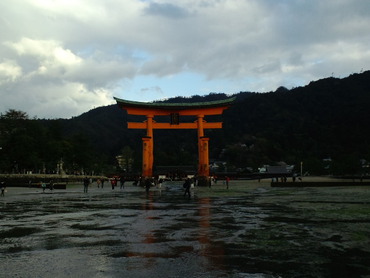

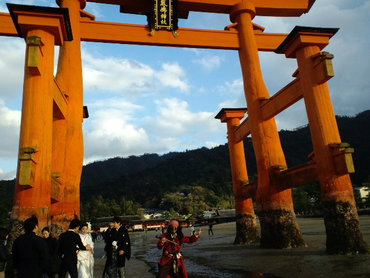
先ほど見た新郎新婦も大鳥居に来ていた。
The couple who I saw earlier came in the ' O-Torii '.
新郎新婦と一緒に写真を撮った。彼らは楽しそうだった。俺もそんな二人を見て嬉しかった。
I took a photo together with the couple and after that they took a photo of me being with them.
They realy have fun.
I am glad to see their smile.
ところで、聞いたところによると、この鳥居は鳥居自体の重みだけで建っているとのことだ。
By the way, I heard that this ' Torii ' is stands by it's own weight.
昔から存在しているものではなくて何度も建て直している。今のものは8代目だということだ。
It was rebuilt on several times.
This ' O-Torii ' is the 8th ' O-Torii '.
一番最近に建て直したのは1871のことだ。
It was rebuilt for the last time on 1871.

この鳥居を真下から見たらどんな風に見えるのだろう?
When I look up from under the ' Torii ' what is it like?

こんな感じだった(^o^)
It looks like this photo.

そして、ついに大鳥居に触ることができたぞ!!
At last, I could touch the ' O-Torii '.
この鳥居の素材はクスの木でできている。
O-Torii is material of camphor tree.
クスの木は腐食にたして耐性がある。
Camphor tree has resistance to corrosion.
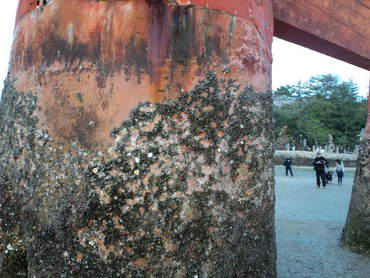
鳥居の土台は石で出来ている。
The foundation is made up of stone.
小さな貝が無数に張り付いていた。
The shellfish has been stuck on the foundation.


グッバイ 厳島神社。またいつか再びここを訪れよう。
Good-by to ' Itsukushima Shrine '. I will visit you again.

彼は電車に乗っていた乗客。
He is a fellow-passenger.
彼はカップルでサンフランシスコから来たと言っていた。
He said that He is with his partner and from San Francisco.
アジア系の血が混じって居そうだ。
He is an american citizen but with an Asian descent.
厳島神社には様々な国から訪問者が訪れていた。
The Itsukushima Shrine was visited by visitors from various countries.
フランス・ アラブ首長国連邦・スペイン・タイ・アメリカ、等…
France, United Arab Emirates, Spain, Thailand, Uníted Státes of América, etc….
厳島神社にいると、様々な国の言葉が飛び交うので面白い。
The Itsukushima Shrine is interesting to me because I there are a lots of heard language of foreigners and with that I can hear different languages from various parts of the world.
俺を見て、「有り得ない! 有り得ない! なんで海賊がいるんだよ!www」と言って楽しそうに笑っていた。
When they saw me, they laughed at me merry and said, " No way! No way! How come a pirate is here ?! hahaha!! ".
それとか、俺を見てクスクス笑っていたりとか。
Besides, they chuckled as they saw me.
それは、俺にとって楽しいことだ。(^▽^)/
It was very fun for me.
ところで、海賊の時代と違って今は様々な国籍の人間が英語を話すようになったのだな。
By the way, people of different nationality has spoken English language in present-day all over the world.
These events were different from the pirate era.
それぞれの国で英語を勉強しているらしい。
So, they studies English at each countrys.
さて、俺は西の方角を目指した。
By the way, I went to west.
行き先は、福岡県だ!!
My next destination is ' Hukuoka ' prefecture.
そこにこそ、アマテラスの娘たちはいるはずだ!!
That is the place where in the daughters of ' Amaterasu ' should have their presence !!
厳島神社の章 終わり
This concludes Chapter of ' Itsukushima ' Shrine.
2014年4月4日
Sequel to the last article…
前回の続き
俺は大鳥居に向かった。
I went to the 'O-Torii'.
俺が大鳥居に向かおうとすると、太陽の光が雲の切れ目からさしはじめた。
The sun appears in the cloud when I go to 'O-Torii'.
大鳥居に向かっていた俺だが俺は何かを感じてなぜか鳥居から離れて行った。
However, I went away from ' O-Torii '.
I don't understand the reason.
However, I feel like someone is calling me.
誰かが俺を呼んでいる…
Someone's calling me…
感じる…
I feel…
人ではない、不思議な力を感じる
…mysterious power of something.
誰かが呼んでいる…。
Someone's calling me….
知らぬ間に俺は、誰も居ない海岸に来ていた…。
I arrived at the beach.
Nobody is there on the beach….
雲の上から声が聞こえる…。
I hear voice coming from above the clouds.
女の美しい声だ。
It is a beautiful voice of women.
声の主は俺に言った。
The voice is telling me something.
謎の声:「海賊よ。お前は知っているはずだ。私達がどこにいるのかを。」
The mysterious voice said, " Pirate, you should know where we are.
俺:「たしかに。俺はあなたたちがどこにいるのかを知っている( ̄ー+ ̄)
ところで、あなたは大事なことを忘れている。」
I answered, " Yes, that is true. I knew that where you are. By the way, you forget something important. ( ̄ー+ ̄)
謎の声:「何!?」
The voice said, " What ?! ∑(;゚□゚)yヾ "
俺:「あなたは俺が船長だってことを忘れている。お嬢様。( ̄▽ ̄)」
I answered, " You forget that I am the Captain of Pirate. mademoiselle. ( ̄▽ ̄) "
謎の声:「…(-_-;)」
The mysterious voice said, " …(-_-;) "
謎の声:「…そんなことはどうでもいい…(-_-;) とにかく西へ向かいなさい。」
The mysterious voice saod, " …Whatever…(-_-;) Anyway, you must go to west.
俺「わかりました。お嬢様。<(_ _)>」
I answered, " Aye, aye Ma'am ! <(_ _)> "
そこで、声は聞こえなくなった。
At that time, our conversation was over.
それから、俺は大鳥居に向かった。
Then, I went to ' O-Torii '.
先ほど見た新郎新婦も大鳥居に来ていた。
The couple who I saw earlier came in the ' O-Torii '.
新郎新婦と一緒に写真を撮った。彼らは楽しそうだった。俺もそんな二人を見て嬉しかった。
I took a photo together with the couple and after that they took a photo of me being with them.
They realy have fun.
I am glad to see their smile.
ところで、聞いたところによると、この鳥居は鳥居自体の重みだけで建っているとのことだ。
By the way, I heard that this ' Torii ' is stands by it's own weight.
昔から存在しているものではなくて何度も建て直している。今のものは8代目だということだ。
It was rebuilt on several times.
This ' O-Torii ' is the 8th ' O-Torii '.
一番最近に建て直したのは1871のことだ。
It was rebuilt for the last time on 1871.
この鳥居を真下から見たらどんな風に見えるのだろう?
When I look up from under the ' Torii ' what is it like?
こんな感じだった(^o^)
It looks like this photo.
そして、ついに大鳥居に触ることができたぞ!!
At last, I could touch the ' O-Torii '.
この鳥居の素材はクスの木でできている。
O-Torii is material of camphor tree.
クスの木は腐食にたして耐性がある。
Camphor tree has resistance to corrosion.
鳥居の土台は石で出来ている。
The foundation is made up of stone.
小さな貝が無数に張り付いていた。
The shellfish has been stuck on the foundation.
グッバイ 厳島神社。またいつか再びここを訪れよう。
Good-by to ' Itsukushima Shrine '. I will visit you again.
彼は電車に乗っていた乗客。
He is a fellow-passenger.
彼はカップルでサンフランシスコから来たと言っていた。
He said that He is with his partner and from San Francisco.
アジア系の血が混じって居そうだ。
He is an american citizen but with an Asian descent.
厳島神社には様々な国から訪問者が訪れていた。
The Itsukushima Shrine was visited by visitors from various countries.
フランス・ アラブ首長国連邦・スペイン・タイ・アメリカ、等…
France, United Arab Emirates, Spain, Thailand, Uníted Státes of América, etc….
厳島神社にいると、様々な国の言葉が飛び交うので面白い。
The Itsukushima Shrine is interesting to me because I there are a lots of heard language of foreigners and with that I can hear different languages from various parts of the world.
俺を見て、「有り得ない! 有り得ない! なんで海賊がいるんだよ!www」と言って楽しそうに笑っていた。
When they saw me, they laughed at me merry and said, " No way! No way! How come a pirate is here ?! hahaha!! ".
それとか、俺を見てクスクス笑っていたりとか。
Besides, they chuckled as they saw me.
それは、俺にとって楽しいことだ。(^▽^)/
It was very fun for me.
ところで、海賊の時代と違って今は様々な国籍の人間が英語を話すようになったのだな。
By the way, people of different nationality has spoken English language in present-day all over the world.
These events were different from the pirate era.
それぞれの国で英語を勉強しているらしい。
So, they studies English at each countrys.
さて、俺は西の方角を目指した。
By the way, I went to west.
行き先は、福岡県だ!!
My next destination is ' Hukuoka ' prefecture.
そこにこそ、アマテラスの娘たちはいるはずだ!!
That is the place where in the daughters of ' Amaterasu ' should have their presence !!
厳島神社の章 終わり
This concludes Chapter of ' Itsukushima ' Shrine.
2014年06月02日
Itsukushima Shrine ⑦ Amaterasu and Susanoo アマテラスとスサノオ
Day 4 April 2014
2014年4月4日
sequel to the last article…
前回からの続き

俺は2014年4月4日に厳島神社を訪れた。
I visited 'Itsukushima Shrine' in Miyajima island in Hiroshima last April 4th 2014.
ここは日本の3大絶景としても、また、世界遺産としても知られている。
It has been considered as one of the Three Views of Japan and also known as a World Heritage Site.
この神社の神は市杵島姫を含む3人の女神。
This shrine enshrines gods and this includes the three goddesses and one of them is named ' Ichikishima Hime '.

その3人の女神は『宗像三女神』と呼ばれている。
They are called 'Munakata Three Goddesses'.
↓This is one of the image of "Tagori-hime"田心姫のイメージの一つ

長女の名前は『田心姫』
The eldest goddess is named 'Tagori-hime'
その女神は、気高く畏怖を感じさせる。
This goddess has a noble heart and people respected her with awe.
次女の名前は『湍津姫』
The second goddess is named ' Tagitsu-hime '.
↓This is one of the image of "Tagitsu-hime"湍津姫のイメージの一つ

次女の性格はツンデレ。
The second goddess who her character is "Tsundere" -( To look like you are angry but deep inside, you love and like that person)
↓This is one of the image of "Tsun-dere" ツンデレのイメージの一つ

末女の名前は『市杵島姫』
The youngest goddess is named 'Ichikishima-hime'.
↓This is one of the image of "Ichikishima-hime"いちきしま姫のイメージの一つ
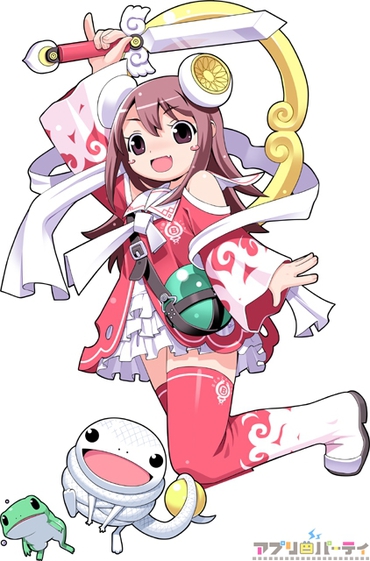
彼女は可愛らしいが、世渡り上手でもある。
She is pretty and cute but cunning and tough.
市杵島姫は弁財天と同じとされている。
' Ichikishima-hime ' is same as 'Benzaiten'.
しかし弁財天は仏教の神だ。
However, ' Benzaiten ' is the God of Buddhism.
本来、仏教と神道は違うものだ。
Originally, Shinto and Buddhism are not the same.
↓This is one of the image of "Shinto" 神道のイメージの一つ

神道では、像が無い。
The Shinto has no idols.
-quote-
Shinto:
Shinto literally mean " the way of the gods ". It is the Japanese religion from ancient times, centering on the ideas of Japanese's intimacy with nature and their ancestors.
All things on earth were brought forth and ruled over by the gods who reside in our nature.
Mountains and trees often become objects of worship. Shrine archways and sacred Shinto ropes mark sacred areas.
Usually, when shrines are built, objects of worship in which a God or Gods reside are enshrined there.
神道:
神道は日本古来の宗教であり、日本人の自然観と先祖崇拝の念がその中核をなしています。
地上の森羅万象は神々によって生み出され、神々の司るところとされ、すべての自然には神が宿るとされます。
山や木は御神体となることが多く、鳥居やしめ縄でそこが神域であることを表します。
普通は神社を建てそこに神が宿る御神体を安置します。
仏教は仏像のようなイメージを持っている。
In Buddism, they have ' Buddhist image ' such as the ' Buddhist statue '. .
↓This is one of the image of "Buddhism" 仏教のイメージの一つ
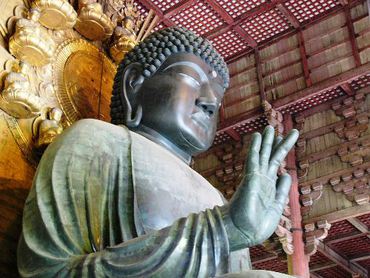
Buddhism :
Buddhism came to Japan in the middle of the sixth century.
Supporters of Buddhism subsequently won a victory in the political power during those struggles times.
Building temples in every area under government patronage spread throughout the country.
仏教:
仏教が日本に伝わったのは6世紀の半ばでした。
その後、当時の政治権力闘争の中で仏教擁護派が勝利を収め、国家の保護の下で各地に寺院が作られ、全国に広められることとなりました。
-unquote-
source of quote : A Bilingual Handbook on Japanese Culture
しかし、神仏習合というものがおこり、市杵島姫は弁財天と同様のものになった。
However, ' Ichikishima-hime ' was became the same as the 'Benzaiten' because ' Shinto-Buddhist synthesis ' occurred to her.
↓This is one of the ’Benzaiten’ 弁財天のイメージの一つ

-quote-
Shinto-Buddhist synthesis :
long time ago in Japan, Buddhism, which came from abroad, and Shinto, which is a folk religion, occasionally came together in a synthesis.
Because Buddhism is not a theistic doctrine and Shinto principally worships nature, there were no contradictions in synthesizing them.
This is called ' shinbutsu-shuugo ’.
This tendency continued for a long time after Buddhism was introduced in the sixth century, with Shinto shrines supporting the construction of Buddhist temples.
神仏習合:
日本では昔から、外来の仏教と民族宗教である神道が、時には合成されたりして共存してきました。
仏教は有神教ではなく、一方神道は自然崇拝を主としているため、合成されても矛盾が生じなかったのです。
これを神仏習合といいます。
6世紀の仏教伝来以来、仏教寺院の建設を神社が補助するなど、この傾向は長く続きました。
When Japan began to function as a modern nation-state in 1868, 'shibutsu-shuugo' was prohibited because the goverment set a policy of strengthening Shinto.
But now, it is quite common to set up both Buddhist family altars and Shinto family altars in the same house or to have weddings with Shinto rituals and funerals with Buddhist rituals.
Weddings with Shinto rituals
↑This is one of the image of ancestor-worship
日本が近代国家として発足するとき(1868)に政府が神道強化の方針をとったため神仏習合が禁止されたこともありましたが、現在でも、同一家庭内に仏壇と神棚の両方が置かれていたり、結婚式は神社で挙げるのに葬式は仏式で行なうといったことが、ごくふつうに行なわれています。
-unquote-
source of quote : A Bilingual Handbook on Japanese Culture
弁財天は、七福神の一人でもある。
' Benzaiten ' as one of ' Shichifukujin (The seven gods who make people's dreams come true)'.
-quote-
Shichifukujin(The Seven gods of good luck) :
Shichifukujin are the seven gods that bring good luck.
They are representative of gods and holy persons in Buddhism, Shintoism and Taoism and are often drawn riding in a treasure ship.
It has been said that people in japan, following the story of seven holy men in ancient China, put together seven gods of good luck and came to believe in them.
七福神は、福をもたらす7人の神です。
仏教や神道、道教などの神や聖人から成るもので、よく宝船に乗った姿で描かれます。
かつて中国の故事に7人の聖者の話があったのに倣い、日本でも縁起のよい7人の神を集めて信仰するようになったといわれています。
' Shichifukujin ' became widely known in the Muromachi Period (1333-1573).
Nowadays, at temples and shrines with ' shichifukujin ' connections, people pray for long life and family well-being, while merchants, who are hoping for business success, display ' Shichifukujin ' pictures.
七福神が広まったのは室町時代(1333~1573)ごろからですが、現在でも、七福神ゆかりの神社で長寿や家内安全を祈ったり、商家が商売繁盛を願って七福神の絵を飾ったりすることがあります。
-unquote-
source of quote : A Bilingual Handbook on Japanese Culture
俺は3人の女神に会いたくて、厳島神社にきたのだ。
I wanted to meet the 'Munakata Three Goddesses', so I visited Itsukushima shrine.
なぜなら、3人とも信じられないほどの美人 と聞いたからだ。
The reason why, is that I have heard that they're unbelievably beautiful.
それに、彼女たちは航海の神でもある。
Moreover, they're the goddess for safe travel and voyage.
そして、船乗りと旅人にとっての神でもある。
So goddess of the sailors and travellers.
俺は海賊だから航海の神に会うことは意味のあることだ。
It's important for me because I am pirate.
彼女たちは、アマテラスとスサノオの娘たちだ。
They are daughters of ' Amaterasu' and ' Susanoo'.
アマテラスとは?
Who is Amaterasu?
↓This is one of the image of "Amaterasu" アマテラスのイメージの一つ
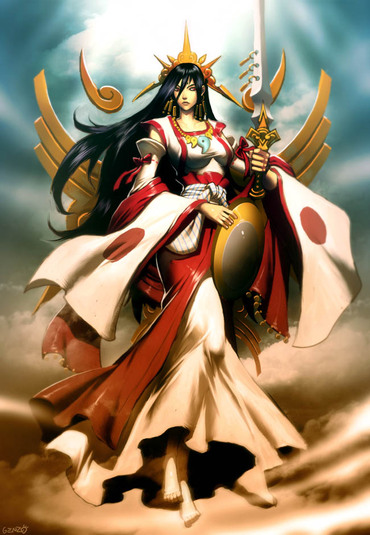
アマテラスは、太陽の神であり最高神でもある女神だ。
Amaterasu is the supreme deity and the goddess of sun.
日本において最も良く知られた神であると言っても良い。
Amaterasu is the most widely known deity.
-quote-
Amaterasu is a part of the Japanese myth cycle and also a major deity of the Shinto religion. She is the goddess of the sun, but also of the universe. The name Amaterasu derived from Amateru meaning "shining in heaven." The meaning of her whole name, Amaterasu-ōmikami, is "the great august kami (God) who shines in the heaven".
The Emperor of Japan is said to be a direct descendant of Amaterasu.
アマテラスは日本の神話の神の一人であり、神道においても重要な神である。
彼女は太陽の神であるが、 天地万有の神でもある。
アマテラスの名前は「天界を照らす」という意味から来ている。
天照大神はとても尊厳な天界の神である。
天皇はアマテラスの直系の子孫であると言われていた。
-unquote-
source of quote : Wikipedia
スサノオとは?
Who is Susanoo?
↓This is one of the image of "Susanoo" スサノオのイメージの一つ
スサノオはアマテラスの弟である。
Susanoo is younger brother of Amaterasu.
彼は、海と嵐の神で、気丈が荒く粗暴な性格である反面、母のいる国に行きたいと言って泣き叫ぶ子供のような一面もある。
He is the God of sea and storm.
His personality is violent and he can't control his temper, but he is like a child because he cries, for he wants to meet his mother.
また、巨大な怪物『八岐大蛇(ヤマタノオロチ)』を退治した英雄でもある。
Then, he is the hero who slays a monster called ' Yamata-no-orochi.'
↓This is one of the image of ' Ymata- no-Orochi '.

日本では、非常に人気のある神で、映画やアニメ、ゲーム等のキャラクターになることも多い。
He is a very popular God and he is modeled on character in movie, anime, and game, etc in japan.
ところで、俺はこの神社にいても、3女神に出会えた感覚がないのだが…
By the way, I can't sense any of the spirit of the Three Goddesses in the shrine though….
….
俺は3女神に会えるのだろうか?
Can I meet the Three Goddesses?
会えるさ。
It is not a problem.
なぜなら俺はキャプテン・チャック・スパ朗だからだ。
Because I am Captain Chuck Sparrow.
わかったか?
right?
….
…返事がないが、まあいい。(-_-;)
…I can't hear any reply…(-_-;)
But…never mind…(-_-;)
俺は大鳥居に向かった。
I went to the ' O-Torii '.
To be continue…
2014年4月4日
sequel to the last article…
前回からの続き

俺は2014年4月4日に厳島神社を訪れた。
I visited 'Itsukushima Shrine' in Miyajima island in Hiroshima last April 4th 2014.
ここは日本の3大絶景としても、また、世界遺産としても知られている。
It has been considered as one of the Three Views of Japan and also known as a World Heritage Site.
この神社の神は市杵島姫を含む3人の女神。
This shrine enshrines gods and this includes the three goddesses and one of them is named ' Ichikishima Hime '.
その3人の女神は『宗像三女神』と呼ばれている。
They are called 'Munakata Three Goddesses'.
↓This is one of the image of "Tagori-hime"田心姫のイメージの一つ

長女の名前は『田心姫』
The eldest goddess is named 'Tagori-hime'
その女神は、気高く畏怖を感じさせる。
This goddess has a noble heart and people respected her with awe.
次女の名前は『湍津姫』
The second goddess is named ' Tagitsu-hime '.
↓This is one of the image of "Tagitsu-hime"湍津姫のイメージの一つ

次女の性格はツンデレ。
The second goddess who her character is "Tsundere" -( To look like you are angry but deep inside, you love and like that person)
↓This is one of the image of "Tsun-dere" ツンデレのイメージの一つ

末女の名前は『市杵島姫』
The youngest goddess is named 'Ichikishima-hime'.
↓This is one of the image of "Ichikishima-hime"いちきしま姫のイメージの一つ

彼女は可愛らしいが、世渡り上手でもある。
She is pretty and cute but cunning and tough.
市杵島姫は弁財天と同じとされている。
' Ichikishima-hime ' is same as 'Benzaiten'.
しかし弁財天は仏教の神だ。
However, ' Benzaiten ' is the God of Buddhism.
本来、仏教と神道は違うものだ。
Originally, Shinto and Buddhism are not the same.
↓This is one of the image of "Shinto" 神道のイメージの一つ

神道では、像が無い。
The Shinto has no idols.
-quote-
Shinto:
Shinto literally mean " the way of the gods ". It is the Japanese religion from ancient times, centering on the ideas of Japanese's intimacy with nature and their ancestors.
All things on earth were brought forth and ruled over by the gods who reside in our nature.
Mountains and trees often become objects of worship. Shrine archways and sacred Shinto ropes mark sacred areas.
Usually, when shrines are built, objects of worship in which a God or Gods reside are enshrined there.
神道:
神道は日本古来の宗教であり、日本人の自然観と先祖崇拝の念がその中核をなしています。
地上の森羅万象は神々によって生み出され、神々の司るところとされ、すべての自然には神が宿るとされます。
山や木は御神体となることが多く、鳥居やしめ縄でそこが神域であることを表します。
普通は神社を建てそこに神が宿る御神体を安置します。
仏教は仏像のようなイメージを持っている。
In Buddism, they have ' Buddhist image ' such as the ' Buddhist statue '. .
↓This is one of the image of "Buddhism" 仏教のイメージの一つ

Buddhism :
Buddhism came to Japan in the middle of the sixth century.
Supporters of Buddhism subsequently won a victory in the political power during those struggles times.
Building temples in every area under government patronage spread throughout the country.
仏教:
仏教が日本に伝わったのは6世紀の半ばでした。
その後、当時の政治権力闘争の中で仏教擁護派が勝利を収め、国家の保護の下で各地に寺院が作られ、全国に広められることとなりました。
-unquote-
source of quote : A Bilingual Handbook on Japanese Culture
しかし、神仏習合というものがおこり、市杵島姫は弁財天と同様のものになった。
However, ' Ichikishima-hime ' was became the same as the 'Benzaiten' because ' Shinto-Buddhist synthesis ' occurred to her.
↓This is one of the ’Benzaiten’ 弁財天のイメージの一つ

-quote-
Shinto-Buddhist synthesis :
long time ago in Japan, Buddhism, which came from abroad, and Shinto, which is a folk religion, occasionally came together in a synthesis.
Because Buddhism is not a theistic doctrine and Shinto principally worships nature, there were no contradictions in synthesizing them.
This is called ' shinbutsu-shuugo ’.
This tendency continued for a long time after Buddhism was introduced in the sixth century, with Shinto shrines supporting the construction of Buddhist temples.
神仏習合:
日本では昔から、外来の仏教と民族宗教である神道が、時には合成されたりして共存してきました。
仏教は有神教ではなく、一方神道は自然崇拝を主としているため、合成されても矛盾が生じなかったのです。
これを神仏習合といいます。
6世紀の仏教伝来以来、仏教寺院の建設を神社が補助するなど、この傾向は長く続きました。
When Japan began to function as a modern nation-state in 1868, 'shibutsu-shuugo' was prohibited because the goverment set a policy of strengthening Shinto.
But now, it is quite common to set up both Buddhist family altars and Shinto family altars in the same house or to have weddings with Shinto rituals and funerals with Buddhist rituals.
Weddings with Shinto rituals
↑This is one of the image of ancestor-worship
日本が近代国家として発足するとき(1868)に政府が神道強化の方針をとったため神仏習合が禁止されたこともありましたが、現在でも、同一家庭内に仏壇と神棚の両方が置かれていたり、結婚式は神社で挙げるのに葬式は仏式で行なうといったことが、ごくふつうに行なわれています。
-unquote-
source of quote : A Bilingual Handbook on Japanese Culture
弁財天は、七福神の一人でもある。
' Benzaiten ' as one of ' Shichifukujin (The seven gods who make people's dreams come true)'.
-quote-
Shichifukujin(The Seven gods of good luck) :
Shichifukujin are the seven gods that bring good luck.
They are representative of gods and holy persons in Buddhism, Shintoism and Taoism and are often drawn riding in a treasure ship.
It has been said that people in japan, following the story of seven holy men in ancient China, put together seven gods of good luck and came to believe in them.
七福神は、福をもたらす7人の神です。
仏教や神道、道教などの神や聖人から成るもので、よく宝船に乗った姿で描かれます。
かつて中国の故事に7人の聖者の話があったのに倣い、日本でも縁起のよい7人の神を集めて信仰するようになったといわれています。
' Shichifukujin ' became widely known in the Muromachi Period (1333-1573).
Nowadays, at temples and shrines with ' shichifukujin ' connections, people pray for long life and family well-being, while merchants, who are hoping for business success, display ' Shichifukujin ' pictures.
七福神が広まったのは室町時代(1333~1573)ごろからですが、現在でも、七福神ゆかりの神社で長寿や家内安全を祈ったり、商家が商売繁盛を願って七福神の絵を飾ったりすることがあります。
-unquote-
source of quote : A Bilingual Handbook on Japanese Culture
俺は3人の女神に会いたくて、厳島神社にきたのだ。
I wanted to meet the 'Munakata Three Goddesses', so I visited Itsukushima shrine.
なぜなら、3人とも信じられないほどの美人 と聞いたからだ。
The reason why, is that I have heard that they're unbelievably beautiful.
それに、彼女たちは航海の神でもある。
Moreover, they're the goddess for safe travel and voyage.
そして、船乗りと旅人にとっての神でもある。
So goddess of the sailors and travellers.
俺は海賊だから航海の神に会うことは意味のあることだ。
It's important for me because I am pirate.
彼女たちは、アマテラスとスサノオの娘たちだ。
They are daughters of ' Amaterasu' and ' Susanoo'.
アマテラスとは?
Who is Amaterasu?
↓This is one of the image of "Amaterasu" アマテラスのイメージの一つ

アマテラスは、太陽の神であり最高神でもある女神だ。
Amaterasu is the supreme deity and the goddess of sun.
日本において最も良く知られた神であると言っても良い。
Amaterasu is the most widely known deity.
-quote-
Amaterasu is a part of the Japanese myth cycle and also a major deity of the Shinto religion. She is the goddess of the sun, but also of the universe. The name Amaterasu derived from Amateru meaning "shining in heaven." The meaning of her whole name, Amaterasu-ōmikami, is "the great august kami (God) who shines in the heaven".
The Emperor of Japan is said to be a direct descendant of Amaterasu.
アマテラスは日本の神話の神の一人であり、神道においても重要な神である。
彼女は太陽の神であるが、 天地万有の神でもある。
アマテラスの名前は「天界を照らす」という意味から来ている。
天照大神はとても尊厳な天界の神である。
天皇はアマテラスの直系の子孫であると言われていた。
-unquote-
source of quote : Wikipedia
スサノオとは?
Who is Susanoo?
↓This is one of the image of "Susanoo" スサノオのイメージの一つ
スサノオはアマテラスの弟である。
Susanoo is younger brother of Amaterasu.
彼は、海と嵐の神で、気丈が荒く粗暴な性格である反面、母のいる国に行きたいと言って泣き叫ぶ子供のような一面もある。
He is the God of sea and storm.
His personality is violent and he can't control his temper, but he is like a child because he cries, for he wants to meet his mother.
また、巨大な怪物『八岐大蛇(ヤマタノオロチ)』を退治した英雄でもある。
Then, he is the hero who slays a monster called ' Yamata-no-orochi.'
↓This is one of the image of ' Ymata- no-Orochi '.

日本では、非常に人気のある神で、映画やアニメ、ゲーム等のキャラクターになることも多い。
He is a very popular God and he is modeled on character in movie, anime, and game, etc in japan.
ところで、俺はこの神社にいても、3女神に出会えた感覚がないのだが…
By the way, I can't sense any of the spirit of the Three Goddesses in the shrine though….
….
俺は3女神に会えるのだろうか?
Can I meet the Three Goddesses?
会えるさ。
It is not a problem.
なぜなら俺はキャプテン・チャック・スパ朗だからだ。
Because I am Captain Chuck Sparrow.
わかったか?
right?
….
…返事がないが、まあいい。(-_-;)
…I can't hear any reply…(-_-;)
But…never mind…(-_-;)
俺は大鳥居に向かった。
I went to the ' O-Torii '.
To be continue…
2014年05月15日
Itsukushima Shrine⑥ In the Shrine厳島神社の中で
I thought that the Itsukushima shrine was in the sea water, but when I arrived here I saw that it was on the land.
俺はここに来るまで、厳島神社は常に海水に浸かっているものだと思っていた。

During low tide I can see the land.
だが、このように引き潮のときは、地面が見えるのだ。
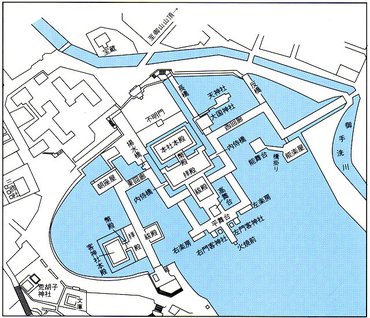
厳島神社の地図↑

Map of Itsukushima Shrine↑

This place is called 'Haraiden'.
彼らは厄払いを受けているようにみえる。
It seems they have 'Yakubarai'(exorcism: to force an evil spirit to leave a person) by Shinto priest.
厄払いとは下記のことである。
'Yakubarai' is as follows.
-quote-
'Oharai'
Shinto purification :
In Shinto,a sin committed by man, whose nature is good, is considered to be caused by impurity.
Any body, without knowing it, can acquire impurity, and sins and misfortunes occur if it accumulates.
Therefore, receiving oharai from time to time has been thought necessary to cleanse the impurities. There are various kinds of Oharai. For example, in addition to sprinkling salt or cleaning one's hands or mouth with water, which can be done by oneself, calamity and impurity are also exorcised by having a Shinto priest at a shrine wave in a sweeping motion a sacred staff with cut paper attached to it.
神道 浄化
神道において、本来の人間は善良であり、穢れによって罪を犯すと考えられています。
誰もが知らないうちに穢れが身に付いてしまい、それがたまると罪や災いがおこります。
したがって、時にはお祓いをうけて穢れを清める必要があるとされてきました。
様々な種類のお祓いがあります。
例えば、自分で塩を撒いたり手や口を水で清めたりするほか、神社で神主に御幣を振ってもらって、災難や穢れを取り払ってもらうこともあります。
'Yakudoshi'
Unlucky age :
With Yakudoshi there is a big chance of encountering misfortune or injuring one's health, so it is an age when one must be careful. The yakudoshi age is determined by adding one year to the actual age, which occurs for men at 25,42, and 60, and for women at 19 and 33. The ages of 42 for men and 33 for women are considered to be particularly bad years,and are called "great calamity". This may be just a superstition, but, because there have been many occasions when theae ages actually have corresponded to turning point in people's health or jobs, there are those who go to Shinyto shrines for exorcism.
厄年
厄年とは、災難にあったり健康を害したりするおそれが多いので、注意しなければならないとされる年です。
年齢に1を加えた歳で、男性は25歳、42歳、60歳、女性は19歳、33歳です。
男性の42歳、女性の33歳は特に悪い年とされ、『大厄』と呼ばれます。
これはただの一つの迷信かもしれませんが、これらの年齢が実際に健康上、仕事上の転機に当たることも多いため、神社に厄払いに行く人もいます。
-unguote-
source of a quote : 日本文化を英語で紹介する辞典 A bilingual Hand book on Japanese Culture
俺は厄払いをしてもらったことがある。穂高神社で今年の1月に今年は厄年なので。
I had 'Yakubarai(exorcism)' in Hotaka shrine on janualy this year because 'Yakudoshi(unlucky age)' for me in this year.

ここは祓殿(はらえどの) というところだ。
In this picture it is called 'Hraedono (The Purification Hall)'.
今、ちょうど結婚式がおこなわれているところだ。
There is 'Kekkonshiki' (Wedding ceremony) in here just now.
神社で結婚式を行なう人も多い。
Many people they have there wedding in a shrine.
-guote-
Wedding ceremonies :
Contemporary Japanese weddings are a mix of traditional and are contemporary aspects and are carried out in a variety of ways.
Holding the ceremony at a specialized wedding hall in accordance with Shinto, Buddhist, or Christian rites and going on honeymoons are compareratively recent practices.
In Kekkonshiki there are two essential elemants : the ritual ceremony and the wedding reception. Large numbers of friends are invited to the wedding reception, which takes place in grand style at hotels.
結婚式 :
現代の日本の結婚式は、伝統的な部分と現代的な部分が混在して、さまざまな形式で行なわれています。
専門の式場で神道、仏教、キリスト教などの作法に従って夫婦の誓いをしたり、新婚旅行に出かけたりするのは、比較的新しい習慣です。
結婚式には儀式と披露宴という2つの要素があり、披露宴は大勢の知人を招いて、ホテルなどで盛大に行なわれます。
-unquote-
source of quote : A bilingual Hand book on Japanese Culture 日本文化を英語で紹介する辞典

新郎新婦の前で仮面をつけた男がゆっくりと舞いを踊っている。
There is a man who is wearing mask and he is dancing slowly in front of bridal pair.


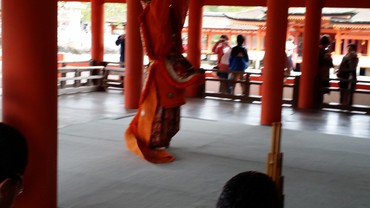





この男の舞は『舞楽』と呼ばれるものだ。
His dance is called 'Bugaku (ancient court dance and music)'.
-quote-
雅楽Ancient court music:
Gagaku is Japanese musical composition modeled on the music and dance brought from China and Korea in ancient times.
Unique instruments are used such as a reed instrument, Shinto flute, thirteen-stringed koto, Japanese lute and drum.
Gagaku flourished in the Heian Period (794-1185) and was performed at temples and shrines.
There are gagaku pieces with dance and without dance, the former calld ancient court dance and music (bugaku) and the latter orchestral music with wind and string instruments (kangen.)
With bugaku and kangen, even when the music is the same, the tempo and the composition of the musical instruments and dynamics are different.
Rarely performed today, gagaku has been taken over by groups like the music department of the Imperial Household Agency and is performed only on celebratory occasions.
雅楽:
雅楽とは古代に中国・朝鮮などから輸入した音楽と舞、およびそれを模倣した日本製の楽曲です。
笙(しょう)、ひちりき、楽筝(がくそう)、楽琵琶、楽太鼓など独特の楽器が使われます。
宮廷音楽として平安時代(794~1185)に栄え、寺社でも演奏されました。
雅楽には舞のあるものと舞いを伴わないものとがあり、前者を舞楽、後者を管弦といいます。
舞楽と管弦とでは同一の曲でも速度や楽器構成・強弱法などが異なります。
現在は一般ではほとんど演奏されず、わずかに宮内庁楽部などが継承して、祝いの際に演奏するくらいです。
-enquote-
source of quote : A bilingual Hand book on Japanese Culture 日本文化を英語で紹介する辞典
ところで、この神社に授与所と呼ばれる場所があり、俺はそこで御朱印をいただくことができる。
By the way, I can get a "Go-Shuin" (stamps & Inscriptions) where there is place of confer called "Jyuyojyo" in the shrine.
So I got a "Go-Shuin" (stamps & Inscriptions).
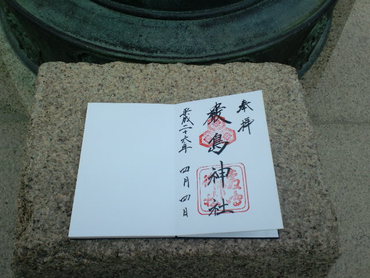
これは厳島神社の御朱印だ。
This is "Go-Shuin" of Itsukushima shrine.
The "Go""御" is an honorific prefix.
In japanese, using "Go" in honorific title that for god.
-quote- -引用-
The Japanese language has three sets of characters - hiragana, katakana, and kanji.
日本の言葉は文字が3つ定まっている。ひらがな、カタカナ、漢字。
Kanji are ideograms, i.e. they stand for both meaning and pronunciation.
漢字は表意文字、言い換えれば、意味と発音を表している。
-unquote-
source of quote : "Teach Yourself Japanese"
-quote- -引用-
Shuin"朱印" = Stamps & Inscriptions.
The pilgrim typically collects stamps and inscriptions from each temple/shrine in the circuit.
朱印=刻印&銘。
巡回で各、寺・神社 から主に巡礼者が収集する印と銘。
Shuin-chō = Stamp Book in which the pilgrim collects stamps and inscriptions from each temple or shrine in the circuit.
朱印帖 = 各、寺院もしくは神社で、巡礼者が集める印と銘の集印帖
-unquote- -引用終わり-
source of quote : "Japanese buddhist Statuary"
俺は祓殿の外に出た。
I already went out in Haraidono (The Purification Hall.)

ここは高舞台と呼ばれている。
In this picture it is called "Takabutai"(High Stage.)
Designated as an Annex to a National Treasure on March 29, 1952.
1952年3月29日 国宝指定
On fine days, often performed the Bugaku (Ancient Court Dance) is held on the High Stage.
晴れた日に舞楽がしばしばこの高舞台で行なわれる。
ところで、京都の伏見稲荷大社も、ここ厳島神社も朱色で塗られている。
By the way, Hushimi Inari grand shrine of Kyoto and also the Itsukushima shrine is painted with vermilion.
Vermilion = a color that is red with an orange tinge.
なぜか?
What do you think so?
なぜなら、朱色は魔除けの力を持っているからだ。
The reason why, it's because vermilion has power of against evil.
-quote-
The vermilion color of the shrine and of the O-torii is considered to keep evil spirits away.
As for Itsukushima Shrine, the shrine buildings are coated with vermilion lacquer, which is also efficient as protection from corrosion.
神社と大鳥居の朱色は、魔除けの力があると考えられています。
朱塗りの塗膜は腐食から建物を守る効果があるゆえでもあります。
-enquote-
source of quoto : welcome to Miyajima
Note : Vermilion (Red mercuric sulphide pigment)
補足 : 銀朱(赤色硫化水銀顔料)

俺がここ宮島に着いたときは、小雨が降っていたが、今は雨があがっている。
Fortunately, the rain stopped already but when I arrived here there is a drizzling rain in Miyajima island.
海水も引けているので、これなら鳥居に触ることができそうだ。
I can touch the Torii now because it is already low tide.
俺は神社から地面に降りた。
I go down from shrine to see the land.
神社の土台を見てみよう。
Let's see the base of the shrine.

これが神社の土台だ。
This is base of shrine.

土台は石と木でできている。
The base of the shrine is made of stone and wood.
それは楠(クスの木)で作られている。
It is made by a camphor tree.
クスの木は腐食しにくいということだ。
camphor tree don't decay easily.
To be continue…
俺はここに来るまで、厳島神社は常に海水に浸かっているものだと思っていた。
During low tide I can see the land.
だが、このように引き潮のときは、地面が見えるのだ。

厳島神社の地図↑

Map of Itsukushima Shrine↑

This place is called 'Haraiden'.
彼らは厄払いを受けているようにみえる。
It seems they have 'Yakubarai'(exorcism: to force an evil spirit to leave a person) by Shinto priest.
厄払いとは下記のことである。
'Yakubarai' is as follows.
-quote-
'Oharai'
Shinto purification :
In Shinto,a sin committed by man, whose nature is good, is considered to be caused by impurity.
Any body, without knowing it, can acquire impurity, and sins and misfortunes occur if it accumulates.
Therefore, receiving oharai from time to time has been thought necessary to cleanse the impurities. There are various kinds of Oharai. For example, in addition to sprinkling salt or cleaning one's hands or mouth with water, which can be done by oneself, calamity and impurity are also exorcised by having a Shinto priest at a shrine wave in a sweeping motion a sacred staff with cut paper attached to it.
神道 浄化
神道において、本来の人間は善良であり、穢れによって罪を犯すと考えられています。
誰もが知らないうちに穢れが身に付いてしまい、それがたまると罪や災いがおこります。
したがって、時にはお祓いをうけて穢れを清める必要があるとされてきました。
様々な種類のお祓いがあります。
例えば、自分で塩を撒いたり手や口を水で清めたりするほか、神社で神主に御幣を振ってもらって、災難や穢れを取り払ってもらうこともあります。
'Yakudoshi'
Unlucky age :
With Yakudoshi there is a big chance of encountering misfortune or injuring one's health, so it is an age when one must be careful. The yakudoshi age is determined by adding one year to the actual age, which occurs for men at 25,42, and 60, and for women at 19 and 33. The ages of 42 for men and 33 for women are considered to be particularly bad years,and are called "great calamity". This may be just a superstition, but, because there have been many occasions when theae ages actually have corresponded to turning point in people's health or jobs, there are those who go to Shinyto shrines for exorcism.
厄年
厄年とは、災難にあったり健康を害したりするおそれが多いので、注意しなければならないとされる年です。
年齢に1を加えた歳で、男性は25歳、42歳、60歳、女性は19歳、33歳です。
男性の42歳、女性の33歳は特に悪い年とされ、『大厄』と呼ばれます。
これはただの一つの迷信かもしれませんが、これらの年齢が実際に健康上、仕事上の転機に当たることも多いため、神社に厄払いに行く人もいます。
-unguote-
source of a quote : 日本文化を英語で紹介する辞典 A bilingual Hand book on Japanese Culture
俺は厄払いをしてもらったことがある。穂高神社で今年の1月に今年は厄年なので。
I had 'Yakubarai(exorcism)' in Hotaka shrine on janualy this year because 'Yakudoshi(unlucky age)' for me in this year.

ここは祓殿(はらえどの) というところだ。
In this picture it is called 'Hraedono (The Purification Hall)'.
今、ちょうど結婚式がおこなわれているところだ。
There is 'Kekkonshiki' (Wedding ceremony) in here just now.
神社で結婚式を行なう人も多い。
Many people they have there wedding in a shrine.
-guote-
Wedding ceremonies :
Contemporary Japanese weddings are a mix of traditional and are contemporary aspects and are carried out in a variety of ways.
Holding the ceremony at a specialized wedding hall in accordance with Shinto, Buddhist, or Christian rites and going on honeymoons are compareratively recent practices.
In Kekkonshiki there are two essential elemants : the ritual ceremony and the wedding reception. Large numbers of friends are invited to the wedding reception, which takes place in grand style at hotels.
結婚式 :
現代の日本の結婚式は、伝統的な部分と現代的な部分が混在して、さまざまな形式で行なわれています。
専門の式場で神道、仏教、キリスト教などの作法に従って夫婦の誓いをしたり、新婚旅行に出かけたりするのは、比較的新しい習慣です。
結婚式には儀式と披露宴という2つの要素があり、披露宴は大勢の知人を招いて、ホテルなどで盛大に行なわれます。
-unquote-
source of quote : A bilingual Hand book on Japanese Culture 日本文化を英語で紹介する辞典

新郎新婦の前で仮面をつけた男がゆっくりと舞いを踊っている。
There is a man who is wearing mask and he is dancing slowly in front of bridal pair.








この男の舞は『舞楽』と呼ばれるものだ。
His dance is called 'Bugaku (ancient court dance and music)'.
-quote-
雅楽Ancient court music:
Gagaku is Japanese musical composition modeled on the music and dance brought from China and Korea in ancient times.
Unique instruments are used such as a reed instrument, Shinto flute, thirteen-stringed koto, Japanese lute and drum.
Gagaku flourished in the Heian Period (794-1185) and was performed at temples and shrines.
There are gagaku pieces with dance and without dance, the former calld ancient court dance and music (bugaku) and the latter orchestral music with wind and string instruments (kangen.)
With bugaku and kangen, even when the music is the same, the tempo and the composition of the musical instruments and dynamics are different.
Rarely performed today, gagaku has been taken over by groups like the music department of the Imperial Household Agency and is performed only on celebratory occasions.
雅楽:
雅楽とは古代に中国・朝鮮などから輸入した音楽と舞、およびそれを模倣した日本製の楽曲です。
笙(しょう)、ひちりき、楽筝(がくそう)、楽琵琶、楽太鼓など独特の楽器が使われます。
宮廷音楽として平安時代(794~1185)に栄え、寺社でも演奏されました。
雅楽には舞のあるものと舞いを伴わないものとがあり、前者を舞楽、後者を管弦といいます。
舞楽と管弦とでは同一の曲でも速度や楽器構成・強弱法などが異なります。
現在は一般ではほとんど演奏されず、わずかに宮内庁楽部などが継承して、祝いの際に演奏するくらいです。
-enquote-
source of quote : A bilingual Hand book on Japanese Culture 日本文化を英語で紹介する辞典
ところで、この神社に授与所と呼ばれる場所があり、俺はそこで御朱印をいただくことができる。
By the way, I can get a "Go-Shuin" (stamps & Inscriptions) where there is place of confer called "Jyuyojyo" in the shrine.
So I got a "Go-Shuin" (stamps & Inscriptions).
これは厳島神社の御朱印だ。
This is "Go-Shuin" of Itsukushima shrine.
The "Go""御" is an honorific prefix.
In japanese, using "Go" in honorific title that for god.
-quote- -引用-
The Japanese language has three sets of characters - hiragana, katakana, and kanji.
日本の言葉は文字が3つ定まっている。ひらがな、カタカナ、漢字。
Kanji are ideograms, i.e. they stand for both meaning and pronunciation.
漢字は表意文字、言い換えれば、意味と発音を表している。
-unquote-
source of quote : "Teach Yourself Japanese"
-quote- -引用-
Shuin"朱印" = Stamps & Inscriptions.
The pilgrim typically collects stamps and inscriptions from each temple/shrine in the circuit.
朱印=刻印&銘。
巡回で各、寺・神社 から主に巡礼者が収集する印と銘。
Shuin-chō = Stamp Book in which the pilgrim collects stamps and inscriptions from each temple or shrine in the circuit.
朱印帖 = 各、寺院もしくは神社で、巡礼者が集める印と銘の集印帖
-unquote- -引用終わり-
source of quote : "Japanese buddhist Statuary"
俺は祓殿の外に出た。
I already went out in Haraidono (The Purification Hall.)

ここは高舞台と呼ばれている。
In this picture it is called "Takabutai"(High Stage.)
Designated as an Annex to a National Treasure on March 29, 1952.
1952年3月29日 国宝指定
On fine days, often performed the Bugaku (Ancient Court Dance) is held on the High Stage.
晴れた日に舞楽がしばしばこの高舞台で行なわれる。
ところで、京都の伏見稲荷大社も、ここ厳島神社も朱色で塗られている。
By the way, Hushimi Inari grand shrine of Kyoto and also the Itsukushima shrine is painted with vermilion.
Vermilion = a color that is red with an orange tinge.
なぜか?
What do you think so?
なぜなら、朱色は魔除けの力を持っているからだ。
The reason why, it's because vermilion has power of against evil.
-quote-
The vermilion color of the shrine and of the O-torii is considered to keep evil spirits away.
As for Itsukushima Shrine, the shrine buildings are coated with vermilion lacquer, which is also efficient as protection from corrosion.
神社と大鳥居の朱色は、魔除けの力があると考えられています。
朱塗りの塗膜は腐食から建物を守る効果があるゆえでもあります。
-enquote-
source of quoto : welcome to Miyajima
Note : Vermilion (Red mercuric sulphide pigment)
補足 : 銀朱(赤色硫化水銀顔料)

俺がここ宮島に着いたときは、小雨が降っていたが、今は雨があがっている。
Fortunately, the rain stopped already but when I arrived here there is a drizzling rain in Miyajima island.
海水も引けているので、これなら鳥居に触ることができそうだ。
I can touch the Torii now because it is already low tide.
俺は神社から地面に降りた。
I go down from shrine to see the land.
神社の土台を見てみよう。
Let's see the base of the shrine.
これが神社の土台だ。
This is base of shrine.
土台は石と木でできている。
The base of the shrine is made of stone and wood.
それは楠(クスの木)で作られている。
It is made by a camphor tree.
クスの木は腐食しにくいということだ。
camphor tree don't decay easily.
To be continue…
2014年05月09日
Itsukushima shrine⑤Torii in the water

That is a Torii.
あれは鳥居。
Torii is a kind of Shrine's Gate.
鳥居は神社のゲートのようなものだ。
-quote-
A torii (鳥居?, lit. bird abode, /ˈtɔəri.iː/)
is a traditional Japanese gate
most commonly found at the entrance of or within a Shinto shrine,
where it symbolically marks the transition
from the profane to the sacred
(see Sacred-profane dichotomy).
-More in the Wikipedia-
-引用-
鳥居は古来日本の門で、普通は入り口か境内に建てられていて、
世俗と聖域の境のような意味をもっている。( 聖俗二元論 を参照)
-詳細はウィキペディアで-

I hope to reach Torii's foot and touch it.
俺は鳥居の足元に行ってさわってみたい。
But before I can reach the Torii, I need to swim in the sea.
しかし鳥居に着くには、海を泳がなければならない。
And I don't feel like doing it..
しかし俺はそれはやりたくないな…。
Because I will be cold and get wet.
寒いし、濡れちまうからなあ。
By the way, why is it the Torii is located in the sea?
ところで、何で鳥居は海の中に建っているんだ?
-quote-
Because the island itself has been considered sacred,
commoners were not allowed to set foot on it throughout much of its history,
in order to maintain its purity.
In order to allow pilgrims to approach, the shrine was built like a pier over the water,
so that it appeared to float, separate from the land.
The shrine's red entrance gate, or torii, was built over the water for much the same reason.
-More in the wikipedia-
-ウィキペディアから引用-
なぜなら、島自体が聖域とされていて、人々は聖域を守るために足を踏み入れることが許されなかった。
それゆえ参拝するために、島から切り離された湾や埠頭のような水に面したところに建てられた。
なので水に浮いているようにも見える。
あの、赤い鳥居も同じ理由により水が被る場所に建てられた。
I'm going to the main shrine.
俺は本殿に向かった。
To be continue.
2014年05月08日
Itsukushima shrine④ Youngest female kami ~~末女
Youngest female kami who is her caracter is pretty, sweet, cute, gentle, mild, meek, clever, cunning and tough.
末っ子の女神の性格は、可愛く、愛らしく、優しく、和やかで、素直で、賢く、抜け目無く、タフ。
She has a smile for everyone she meets through, she used her prestige power.
彼女は皆に笑顔を振る舞い、威光を持っている。
Her name is "Ichikishimahime"
彼女の名前は『市杵島姫(いちきしま姫)』
This is one of the image of "Ichikishimahime"いちきしま姫のイメージの一つ
However, this is her own image.ただし、これは俺が抱いているイメージだ。

from ryohoji

These three female kami is tutelary protecting sea and island and sea lanes.
3人の女神は、海と島と航路の守り神だ。
These three female kami is guarding the nation and protecting the imperial household.
3人の女神は国と皇室を守っている。
These three female kami is enshrined by devout at Itsukushima shrine.
3人の女神は厳島神社に祀られている。

I took this photograph at underpass.
俺はこの写真を地下道で撮った。
The underpass is at the front of JR( West Japan Railway Company ) Miyajima-guchi station.
この地下道はJR宮島口駅前にある。
This photograph is an illustration.
これはイラストレーションの写真だ。
This illustration was designed by student of Interior Design at Hiroshima Prefectual Miyajima Technical High School.
このイラストレーションは、広島県宮島工業高校のインテリアデザイン科の生徒がデザインしたものだ。
http://www.miyajima-th.hiroshima-c.ed.jp/pdf/english.pdf
This picture shows Three female kami.
この絵は3人の女神を表している。
Ichikishimahime was alternately receiving worship as the Indian deity Benzaiten.
いちきしま姫は、インドの神 『弁財天』としても崇拝されている。
This is one of the image of "Benzaiten"
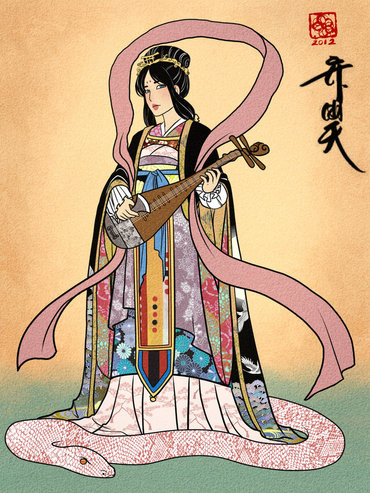
-quote-
Benzaiten (弁才天, 弁財天) is the Japanese name for the Hindu goddess Saraswati. Worship of Benzaiten arrived in Japan during the 6th through 8th centuries, mainly via the Chinese translations of the Sutra of Golden Light, which has a section devoted to her. She is also mentioned in the Lotus Sutra and often depicted holding a biwa, a traditional Japanese lute, in contrast to Saraswati who holds a stringed instrument known as a veena. Benzaiten is a highly syncretic entity with both a Buddhist and a Shinto side.
-More in the Wikipedia-
弁財天はヒンドゥー教の女神『サラスワティ』の日本の名前である。6世紀から8世紀頃、中国から金光明経を通じて日本に伝えられた。法華経では琵琶(古来の日本のリュート)を抱えた姿がしばしば描かれ、サラスヴァティの持つヴィーナとして知られる弦楽器と対照をなしている。弁財天は、神仏習合によって仏教と神道で祀られている。
This is one of the image of "Saraswati"

to be continue…

末っ子の女神の性格は、可愛く、愛らしく、優しく、和やかで、素直で、賢く、抜け目無く、タフ。
She has a smile for everyone she meets through, she used her prestige power.
彼女は皆に笑顔を振る舞い、威光を持っている。
Her name is "Ichikishimahime"
彼女の名前は『市杵島姫(いちきしま姫)』
This is one of the image of "Ichikishimahime"いちきしま姫のイメージの一つ
However, this is her own image.ただし、これは俺が抱いているイメージだ。

from ryohoji

These three female kami is tutelary protecting sea and island and sea lanes.
3人の女神は、海と島と航路の守り神だ。
These three female kami is guarding the nation and protecting the imperial household.
3人の女神は国と皇室を守っている。
These three female kami is enshrined by devout at Itsukushima shrine.
3人の女神は厳島神社に祀られている。
I took this photograph at underpass.
俺はこの写真を地下道で撮った。
The underpass is at the front of JR( West Japan Railway Company ) Miyajima-guchi station.
この地下道はJR宮島口駅前にある。
This photograph is an illustration.
これはイラストレーションの写真だ。
This illustration was designed by student of Interior Design at Hiroshima Prefectual Miyajima Technical High School.
このイラストレーションは、広島県宮島工業高校のインテリアデザイン科の生徒がデザインしたものだ。
http://www.miyajima-th.hiroshima-c.ed.jp/pdf/english.pdf
This picture shows Three female kami.
この絵は3人の女神を表している。
Ichikishimahime was alternately receiving worship as the Indian deity Benzaiten.
いちきしま姫は、インドの神 『弁財天』としても崇拝されている。
This is one of the image of "Benzaiten"

-quote-
Benzaiten (弁才天, 弁財天) is the Japanese name for the Hindu goddess Saraswati. Worship of Benzaiten arrived in Japan during the 6th through 8th centuries, mainly via the Chinese translations of the Sutra of Golden Light, which has a section devoted to her. She is also mentioned in the Lotus Sutra and often depicted holding a biwa, a traditional Japanese lute, in contrast to Saraswati who holds a stringed instrument known as a veena. Benzaiten is a highly syncretic entity with both a Buddhist and a Shinto side.
-More in the Wikipedia-
弁財天はヒンドゥー教の女神『サラスワティ』の日本の名前である。6世紀から8世紀頃、中国から金光明経を通じて日本に伝えられた。法華経では琵琶(古来の日本のリュート)を抱えた姿がしばしば描かれ、サラスヴァティの持つヴィーナとして知られる弦楽器と対照をなしている。弁財天は、神仏習合によって仏教と神道で祀られている。
This is one of the image of "Saraswati"

to be continue…

2014年05月02日
Itsukushima Shrine 厳島神社② Munakata-three-female-kamis 宗像三女神
I visited to Itsukushima shrine.
My purpose is to meet and feel the presence of the kami's.
俺の目的は、女神に会う(感じる)こと。
According to what I heard, female kamis are extremely beautiful.
聞いたところによると、彼女はものすごく美しいらしい。
I heard that she(Godess) have two female kamis(sister).
さらに、彼女には、2人の美しい姉妹がいるのだ!!
The three sisters(goddess) name is the "Three (Sister) female kamis of Munakata".
その3姉妹(女神)の名は、『宗像三女神(姉妹)』
I heard that most of the three female kamis are extremely beautiful.
3姉妹(女神)とも、絶世の美女(女神)だと、俺は聞いた。
The eldest female kami. have literally divine beauty appearance and her character is aloof and inaccessible highly noble.
長女(神)は、気高く近寄りがたい性格で、文字通り神々しく美しい姿をしている。
This is one of the image of the female kamis. ↓俺のイメージはこんな感じ

Goddess (Awakening)
The second female kami who her character is "Tsundere" (ツンデレ, pronounced [tsɯndeɽe]).
次女(女神)の性格は、『ツンデレ』
What is "Tsundere" ?
ツンデレ とは?
To be continue.
My purpose is to meet and feel the presence of the kami's.
俺の目的は、女神に会う(感じる)こと。
According to what I heard, female kamis are extremely beautiful.
聞いたところによると、彼女はものすごく美しいらしい。
I heard that she(Godess) have two female kamis(sister).
さらに、彼女には、2人の美しい姉妹がいるのだ!!
The three sisters(goddess) name is the "Three (Sister) female kamis of Munakata".
その3姉妹(女神)の名は、『宗像三女神(姉妹)』
I heard that most of the three female kamis are extremely beautiful.
3姉妹(女神)とも、絶世の美女(女神)だと、俺は聞いた。
The eldest female kami. have literally divine beauty appearance and her character is aloof and inaccessible highly noble.
長女(神)は、気高く近寄りがたい性格で、文字通り神々しく美しい姿をしている。
This is one of the image of the female kamis. ↓俺のイメージはこんな感じ

Goddess (Awakening)
The second female kami who her character is "Tsundere" (ツンデレ, pronounced [tsɯndeɽe]).
次女(女神)の性格は、『ツンデレ』
What is "Tsundere" ?
ツンデレ とは?
To be continue.
2014年05月01日
Itsukushima Shrine-World Heritage 広島県世界遺産 厳島神社①

At Itsukushima shrine
Itsukushima shrine is located in an island of Itsukushima(popularly known as Miyajima) in hiroshima prefecture.
厳島神社は広島県の厳島島(宮島としてよく知られる)に位置する。
It takes about 13 and harf hours by a local train from Azuminno city in which I am currently living in, From my place I need to go to Hiroshima station.
俺が今住んでいる安曇野市から広島駅まで、各駅停車の電車でおよそ13時間半かかる。
If you in oeder to visit to Itsukushima shrine of Miyazima island , you must to take a ferry.
宮島の厳島神社に行くには、フェリーを使う。
The trip takes about 10 minutes Miyajimaguchi to Miyajima.
More info→Go japan Go.com
There are many deer in Miyajima.
宮島には鹿がたくさんいる。
More info→Wiki travel

Torii's low part In to the water now. soon to low tide.
今、鳥居の低部は水に浸かっている。もうすぐ浅瀬になる。
Torii is like a gate of shrines and temples that built at entrance.
鳥居は神社と寺院の玄関に建てられる門のようなものだ。
My purpose is meet(feel) the female kamis.
俺の目的は、女神に会う(感じる)こと。
According to what I heard, seems she(the female kamis) is superb beautiful !!
聞いたところによると、彼女はものすごく美しいらしい。
To be continue…
つづく
2013年11月03日
★安曇野の人々は海からやってきた21浦島太郎伝説★
志賀島の東側を走る。
集落は無く、切立った崖沿いの道を行く。

ここにも浦島太郎伝説があった。
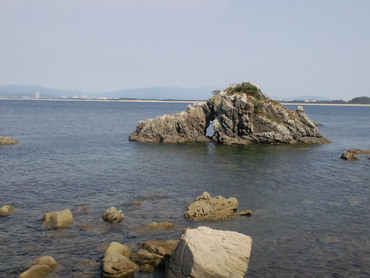
昔、志賀島では南側の志賀地区を「表」と表現し、礎鹿(しか)と呼び、北側の勝馬地区を「裏」と表現し、浦島(裏島)と呼んでいたそうだ。
その浦島に太郎という働き者の若者がおり、村長の一人娘姫子と夫婦になるだろうとうわさされていた。ある夏、太郎が岩場で魚釣りをしていると、 激流に打ちのめされ傷だらけの亀を見つけ、薬草を塗り海に放したところ大あらしになり、太郎は大波にのまれ、翌朝、浜に打ち上げられたそうだ。
村長は村人と看病したが「助けた亀で竜宮に行った」などと口走り、よくなる様子がありませんでした。 村長は太郎の空言を現実に作ろうと、二見岩を美しく染め、そばの料理屋を竜宮城に変え、姫子を乙姫にして、太郎を亀に乗せて行かせた。 乙姫を見た太郎は驚きで正気に戻り、二人はめでたく夫婦に・・・』という話で、同岩で、二人が愛を誓い合ったといわれています。
…この伝説は現実的であり、アインシュタインが提唱した
『相対性理論』
とは、まったくの無縁のようだ。
…竜宮。
…竜の宮?
どこかでそのような名前を聞いた気がするんだが…。
いや、浦島太郎伝説のなかに存在する場所だ。
いろんな情報が入りすぎて、わからなくなっているのかもな。
…つづく
集落は無く、切立った崖沿いの道を行く。
ここにも浦島太郎伝説があった。
昔、志賀島では南側の志賀地区を「表」と表現し、礎鹿(しか)と呼び、北側の勝馬地区を「裏」と表現し、浦島(裏島)と呼んでいたそうだ。
その浦島に太郎という働き者の若者がおり、村長の一人娘姫子と夫婦になるだろうとうわさされていた。ある夏、太郎が岩場で魚釣りをしていると、 激流に打ちのめされ傷だらけの亀を見つけ、薬草を塗り海に放したところ大あらしになり、太郎は大波にのまれ、翌朝、浜に打ち上げられたそうだ。
村長は村人と看病したが「助けた亀で竜宮に行った」などと口走り、よくなる様子がありませんでした。 村長は太郎の空言を現実に作ろうと、二見岩を美しく染め、そばの料理屋を竜宮城に変え、姫子を乙姫にして、太郎を亀に乗せて行かせた。 乙姫を見た太郎は驚きで正気に戻り、二人はめでたく夫婦に・・・』という話で、同岩で、二人が愛を誓い合ったといわれています。
…この伝説は現実的であり、アインシュタインが提唱した
『相対性理論』
とは、まったくの無縁のようだ。
…竜宮。
…竜の宮?
どこかでそのような名前を聞いた気がするんだが…。
いや、浦島太郎伝説のなかに存在する場所だ。
いろんな情報が入りすぎて、わからなくなっているのかもな。
…つづく
2012年02月23日
★寝覚めの床★
松本商店街映画祭
2013年度には出品しようともくろんでいるんだが…。
まずは『脚本』だ。
ん~。
脚本にも、リアリティーを持たせたい。
と、いうわけで、とある日、
『木曽』の『寝覚めの床』
に行ってきた。

岩場を乗り越えて浦島神社へ向かう。

巨大な岩だ。
花崗岩というらしい。
…船のように見えなくもない。

気が付くと、仰向けに寝た状態で倒れていたのだ。

こいつが浦島神社か…。
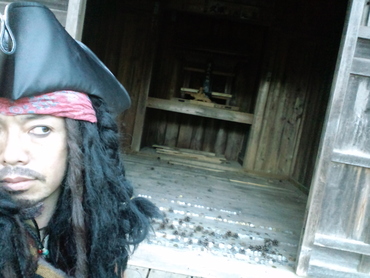
中を覗いてみると…

賽銭がむき出しの形で供えられている。

これだけあれば、電車賃くらいにはなりそうだ。

その奥には、海ガメに乗った浦島太郎が…。
この男だ。
時間を越えて現代にやってきてしまったのは…。
俺の境遇に似ている…。

裏寝覚め?
ちょいとヤバイ寝覚めの床か?┗┓ ̄旦 ̄┏┛フフフ

しかし、道は塞がれている…。
…怪しい…。
政府は何かを隠しているのかもしれん…。
まあいい…。

今日は日が暮れてきたので引き返すとしよう…。
おばけが出てきたら怖いからなあ…(*ノェノ)
2013年度には出品しようともくろんでいるんだが…。
まずは『脚本』だ。
ん~。
脚本にも、リアリティーを持たせたい。
と、いうわけで、とある日、
『木曽』の『寝覚めの床』
に行ってきた。
岩場を乗り越えて浦島神社へ向かう。
巨大な岩だ。
花崗岩というらしい。
…船のように見えなくもない。
気が付くと、仰向けに寝た状態で倒れていたのだ。
こいつが浦島神社か…。
中を覗いてみると…
賽銭がむき出しの形で供えられている。
これだけあれば、電車賃くらいにはなりそうだ。
その奥には、海ガメに乗った浦島太郎が…。
この男だ。
時間を越えて現代にやってきてしまったのは…。
俺の境遇に似ている…。
裏寝覚め?
ちょいとヤバイ寝覚めの床か?┗┓ ̄旦 ̄┏┛フフフ
しかし、道は塞がれている…。
…怪しい…。
政府は何かを隠しているのかもしれん…。
まあいい…。
今日は日が暮れてきたので引き返すとしよう…。
おばけが出てきたら怖いからなあ…(*ノェノ)








